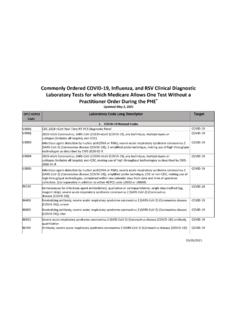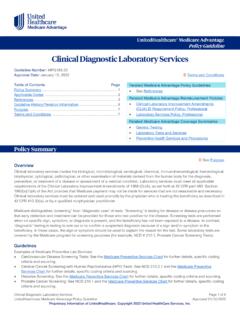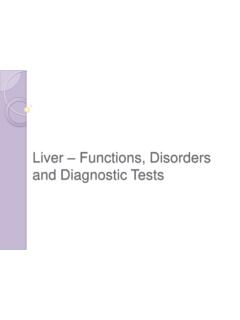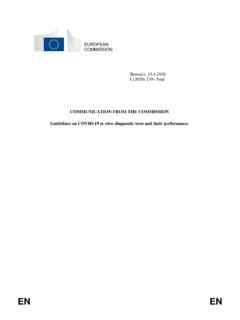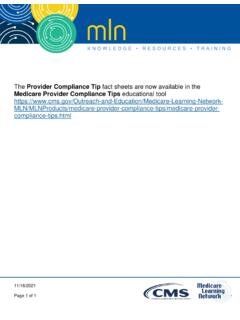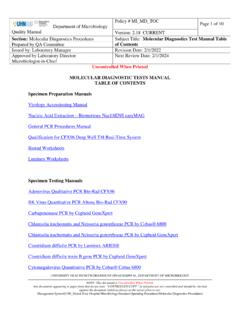Transcription of PRINCIPLES AND METHODS OF VALIDATION OF …
1 2019 OIE - Manual of diagnostic tests for Aquatic Animals - 19/08/20191 CHAPTER AND METHODS OFVALIDATION OF DIAGNOSTIC ASSAYSFOR INFECTIOUS DISEASESINTRODUCTION1 VALIDATION is a process that determines the fitness of an assay2, which has been properly developed,optimised and standardised, for an intended purpose. All diagnostic assays ( laboratory and field assays)should be validated for the species in which they will be used. VALIDATION includes estimates of theanalytical and diagnostic performance characteristics of a test. In the context of this chapter, an assay thathas completed the first three stages of the VALIDATION pathway (see Figure 1 below), including performancecharacterisation, can be designated as validated for the original intended purpose(s) . To maintain avalidated assay status, however, it is necessary to carefully monitor the assay's performance underconditions of routine use, often by tracking the behaviour of assay controls over time.
2 This ensures thatthe assay, as originally validated, consistently maintains its performance characteristics. Should it nolonger produce results consistent with the original VALIDATION data, the assay may be rendered unfit for itsintended purpose(s). Thus, a validated assay is continuously assessed to assure it maintains its fitnessfor purpose through both the assessment of results of the assay controls included with each run andthrough on-going assessment during routine use in the targeted applied to individuals or populations have many purposes, such as aiding in: documentingfreedom from disease in a country or region, preventing spread of disease through trade, contributing toeradication of an infection from a region or country, confirming diagnosis of clinical cases, estimatinginfection prevalence to facilitate risk analysis, identifying infected animals toward implementation ofcontrol measures, and classifying animals for herd health or immune status post-vaccination.
3 A singleassay may be validated for one or more intended purposes by optimising its performance characteristicsfor each purpose, setting diagnostic sensitivity (DSe) high, with associated lower diagnostic specificity(DSp) for a screening assay, or conversely, setting DSp high with associated lower DSe for a ever-changing repertoire of new and unique diagnostic reagents coupled with many novel assayplatforms and protocols has precipitated discussions about how to properly validate these assays. It is nolonger sufficient to offer simple examples from serological assays, such as the enzyme-linkedimmunosorbent assay, to guide assay developers in validating the more complex assays, such as nucleicacid detection tests . In order to bring coherence to the VALIDATION process for all types of assays, thischapter focuses on the criteria that must be fulfilled during assay development and VALIDATION of all assaytypes.
4 The inclusion of assay development as part of the assay VALIDATION process may seemcounterintuitive, but in reality, three of the required VALIDATION criteria (definition of intended purpose[s],optimisation, and standardisation) that must be assessed in order to achieve a validated assay, comprisesteps in the assay development process. Accordingly the assay development process seamlessly leadsinto an assay VALIDATION pathway, both of which require fulfilment of VALIDATION criteria. Further, moredetailed guidance is provided in a series of Recommendations for VALIDATION of diagnostic tests3 that aretailored for several fundamentally different types of assay ( detection of nucleic acids, antibodies, orantigens) and provide more information on specific issues related to the VALIDATION of diagnostic specific information for wildlife species, refer to Chapter PRINCIPLES and METHODS for thevalidation of diagnostic tests for infectious diseases applicable to wildlife of the Manual of Diagnostic Testsand Vaccines for Terrestrial Animals.
5 The information provided in Chapter , which is specific towildlife species, might also be useful for domestic animal test VALIDATION , for example, where the numberor availability of samples is : Version adopted by the World Assembly of Delegates of the OIE in May , test method and test are synonymous terms for purposes of this chapter, and therefore are used interchangeably3 Available at: at: OIE - Manual of diagnostic tests for Aquatic Animals - 19/08/2019 Chapter - PRINCIPLES and METHODS of VALIDATION of diagnostic assays for infectious diseasesPRELIMINARY CONSIDERATIONS IN ASSAY DEVELOPMENT AND VALIDATIONAll laboratories should comply with the requirements of Chapter (Aquatic Manual) or Chapter (TerrestrialManual) on Quality management in veterinary testing laboratories. This will minimise the influence of factors that do notdepend on the test itself such as instrumentation, operator error, reagent choice (both chemical and biological) andcalibration, reaction vessels and platforms, water quality, pH and ionicity of buffers and diluents, incubation temperaturesand durations, and errors in the technical performance of the first step in assay development is to define the purpose of the assay, because this guides all subsequent steps inthe VALIDATION process.
6 Assay VALIDATION criteria are the characterising traits of an assay that represent decisive factors,measures or standards upon which a judgment or decision may be based. By considering the variables that affect anassay's performance, the criteria that must be addressed in assay VALIDATION become clearer. The variables can begrouped into categories such as: (a) the sample individual or pooled, matrix composition, and host/organisminteractions affecting the target analyte quantitatively or qualitatively; (b) the assay system physical, chemical,biological and operator-related factors affecting the capacity of the assay to detect a specific analyte in the sample; and(c) the test result interpretation - the capacity of a test result, derived from the assay system, to predict accurately thestatus of the individual or population relative to the purpose for which the assay is , collection, preparation, preservation and management of samples are critical variables in design anddevelopment of an assay to ensure valid test results.
7 Other variables such as transport, chain of custody, tracking ofsamples, and the laboratory information management system are also key sources of variation/error that becomeespecially important when the assay is implemented for routine testing. Integrity of experimental outcomes during assaydevelopment and VALIDATION is only as good as the quality of the samples used. Anticipating the factors that cannegatively impact sample quality must precede launching an assay VALIDATION effort. Reference samples used in assaydevelopment and VALIDATION should be in the same matrix that is to be used in the assay ( serum, tissue, whole blood)and representative of the species to be tested by the assay. The reference materials should appropriately represent therange of analyte concentration to be detected by the assay. Information on sample collection, preparation, preservation,management, and transport is available in chapters and of the Terrestrial matrix in which the targeted analyte is found (serum, faeces, tissue, etc.)
8 May contain endogenous or exogenousinhibitors that prevent some assays from working. This is of particular concern for enzyme-dependent tests such aspolymerase chain reaction (PCR) or enzyme-linked immunosorbent assay (ELISA). Other factors that affect theconcentration and composition of the target analyte (particularly antibody) in the sample may be mainly attributable tothe host and are either inherent ( age, sex, breed, nutritional status, pregnancy, immunological responsiveness) oracquired ( passively acquired antibody, active immunity elicited by vaccination or infection). Non-host factors, suchas contamination or deterioration of the sample, also potentially affect the ability of the assay to detect the specifictargeted analyte in the sample. It is also important that biological reagents are free of extraneous agents that mightotherwise lead to erroneous CRITERIA OF ASSAY DEVELOPMENT AND VALIDATIONA ssay performance is affected by many factors beginning with optimisation of the assay.
9 After initial optimisation for anintended purpose, characteristics of the performance of the assay will be tested. The assay may need additionaloptimisation or may be found to be fit for purpose based on the results of the VALIDATION for assay development and validationi)Definition of the intended purpose(s)ii)Optimisationiii)Standardisa tioniv)Repeatabilityv)Analytical sensitivityvi)Analytical specificityvii) Thresholds (cut-offs)viii) Diagnostic sensitivityix)Diagnostic specificityChapter - PRINCIPLES and METHODS of VALIDATION of diagnostic assays for infectious diseases2019 OIE - Manual of diagnostic tests for Aquatic Animals - 19/08/2019 3x)Reproducibilityxi)Fitness for intended purpose(s)1. ASSAY DEVELOPMENT Definition of the intended purpose(s) for an assayThe OIE Standard for Management and Technical Requirements for Laboratories Conducting tests for InfectiousDiseases (World Organisation for Animal Health (OIE), 2008)5 states that test METHODS and related proceduresmust be appropriate for specific diagnostic applications in order for the test results to be of relevance.
10 In otherwords, the assay must be fit for purpose . The qualitative and quantitative assessment of capacity of a positive ornegative test result to predict accurately the infection or exposure status of the animal or population of animals isthe ultimate consideration of assay VALIDATION . This capacity is dependent on development of a carefully optimisedand standardised (Section ) assay that, through accrual of VALIDATION data, provides confidence in the assay sability to perform according to the intended purpose. In order to ensure that test results provide useful diagnosticinferences about animals or populations with regard to the intended purpose, the VALIDATION process encompassesinitial development and assay performance documentation, as well as on-going assessment of quality control andquality assurance programmes. Figure 1 shows the assay VALIDATION process, from assay design through thedevelopment and VALIDATION pathways to implementation, deployment, and maintenance of the first step of assay development is selection of an assay type that is appropriate and that likely can be validatedfor a particular use (fitness for purpose).










